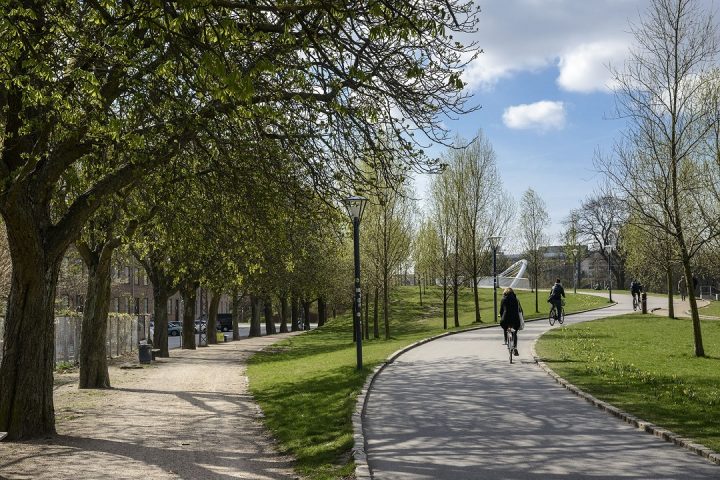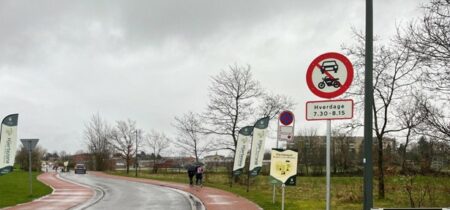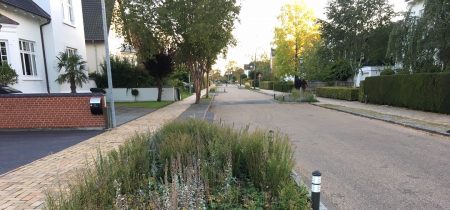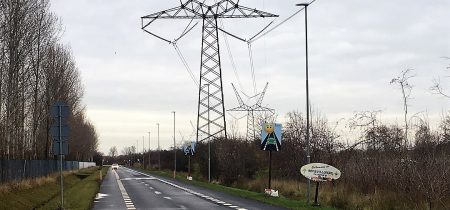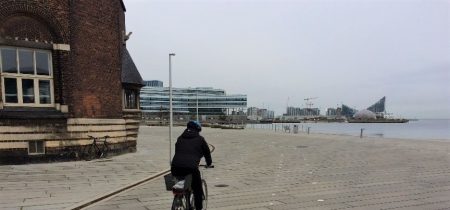Bridges, tunnels, stairs, and hills
It’s important to carefully weigh all the advantages and disadvantages before choosing between a bicycle bridge or a tunnel. Then comes the choice of a number of details that may be crucial to the quality of the solution. Stairs can be designed with different facilities to help cyclists go up and down. Hills can reduce bicycle traffic.
By Troels Andersen
Bridge or tunnel?
Sometimes planners need to choose between a bicycle bridge or a tunnel. The cost difference is a factor that can go both ways, depending on the circumstances.
A bridge normally needs a clearance height of 4.5 m above a road, and 7-8 m above railway overhead wires. This means that a ramp needs to be either steep or long. On the other hand cyclists sometimes get a great view. In addition, a bridge can be seen far away and helps cyclists to find their way.

- This cycle track bridge has segregated areas for cyclists and pedestrians, and the cyclist ramp gradient is kept at max. 62%. Photo Odense municipality
A cycle track tunnel must normally have 2.8 m headroom for cyclists due to snow clearance and sweeping. Tunnel ramps don’t need to be as steep or as long as bridge ramps. On the other hand the route is darker and sometimes feels less secure.
When passing over water (sea, stream, or brook), a bridge is normally the preferred solution. The cost is greatly affected if the bridge needs to be opened to allow ships to pass through.

- Beautifully designed bridge. Photo Aarhus municipality
Bridges
High railings are necessary on bridges where there are pedestrians, cyclists and lorries. The recommended height is 1.2 m. It must not be possible for a cyclist to fall under the railing. On bridges with heavy winds it’s a good idea to install wind screens for cyclists. There are no recommended heights for wind screens due to too little experience. Another, rarer option is to build indoor cycle tracks.

- A bicycle bridge doesn’t need to be big and expensive. This small, wooden bridge over the brook makes cycling a delightful experience. Photo Troels Andersen
Tunnels
Lighting both inside and outside the tunnel is essential. There are many tunnels that should be lit 24 hours a day. What’s going on inside the tunnel should be visible from the outside, and it should be possible to see through the entire tunnel at once. Apertures can be installed in new tunnels to bring longed for daylight down to the cyclists. The aperture can be installed where there are traffic islands or other free areas on the road overhead.

- Dark, narrow tunnel. Photo Troels Andersen
Pedestrians and cyclists should be segregated in tunnels to the greatest possible extent. However, this significantly increases the cost, and the need should be assessed on the basis of estimated number of pedestrians, especially the estimated number of walking children.
Barriers, bollards and sharp curves should not occur in or directly outside tunnels.

- Excellent, new bicycle tunnel under the light rail. Photo Troels Andersen

- New cycle track tunnel where the sides of the tunnel lean outwards and there are apertures for daylight. Photo Troels Andersen
Cycling under Odense
It is now possible to cycle underground in Odense city center, an important shortcut for cyclists.
Four lane Thomas B. Thriges Gade was closed to traffic and construction began on residences, offices, shops, cultural institutions, restaurants, and cafés. There is an underground car park and there will be green squares and urban spaces above ground. There will be a cycle superhighway running north- south through the new neighborhood.
The underground car park will have a total of 5 ramps with a capacity of 1,000 parking spaces and 300 bike racks.
The northern half of the car park opened in 2016. There are entrances on three streets. Cycling is allowed on two of the ramps to make it easier for cyclists to gain access to the bicycle parking facilities, and similar options are being considered for the next two ramps. This means that cyclists will potentially be able to cycle underground via four ramps. The head clearance is sufficient for cyclists, and car speeds are calmed by speed bumps.
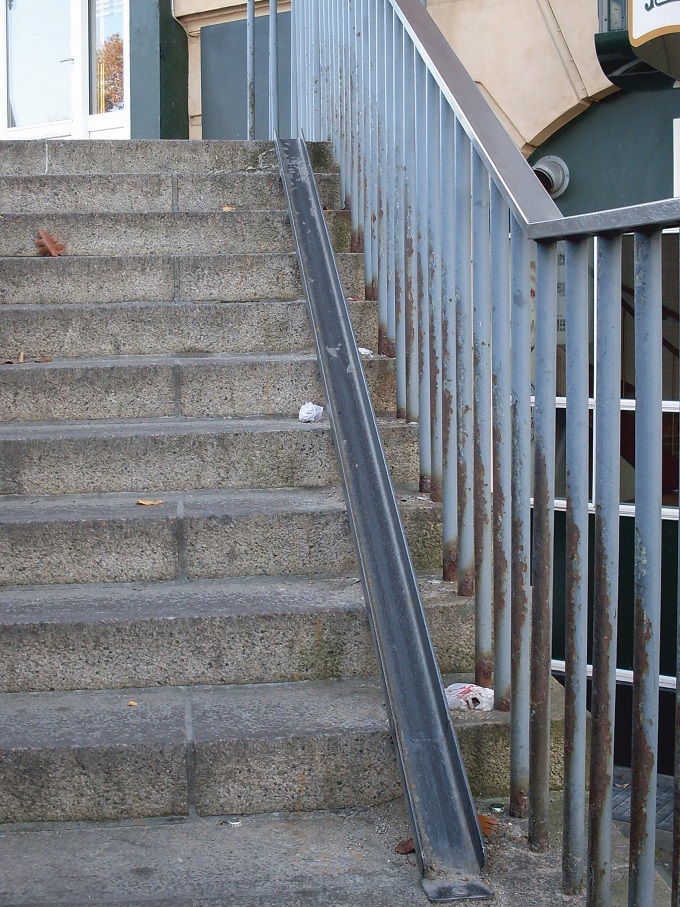
- A simple metal track can make a big difference to cyclists. Photo Troels Andersen
Staircases
Staircases are not made for cyclists, but it should always be possible for cyclists to navigate them. Cycle ramps can be a good idea on staircases, especially at stations, underground parking facilities, bridges, and tunnels. Almost all cyclists wheel their bikes on their right side.
When space is narrow, the cycle ramp on the right side going up is the most important one to establish. A ramp on each side of the stairs is important so cyclists can go up and down easily without having to carry their bicycles. At stations and similar locations a wide double staircase with a railing in the middle is the preferred solution. If prams etc. should be able to use the ramp, the design must be adjusted accordingly.
The cycle ramp should be 0.3m wide and the railing should be high enough that it doesn’t get in the way of a cyclist wheeling a bicycle. Where there are many cycle tourists, 0.5- 0.6m wide cycle ramps can be a good idea so cyclists don’t need to remove their panniers before using the ramp. However, wide cycle ramps are not the best solution everywhere. When a staircase has a modest or a moderate incline there is the risk that cyclists will ride down a wide ramp, which can be dangerous.
A depression can be made in the cycle ramp for the bicycle wheels so it’s easier to wheel the bicycle. The staircase’s incline should not exceed 25 degrees, otherwise it’s hard to wheel the bike up and hard to control it on the way down.
There are cycle ramps that brake cycles going down and help cycles going up with an electric conveyor belt.
Very few cyclists will normally use elevators – it takes too long.

- Combined cycle and pram ramp. It should have been placed on the opposite side for right handed cyclists going up the staircase. Photo Troels Andersen
See the video of a system that helps cyclists go up and down stairs. https://youtu.be/V3y6WqY71HA
Hills
Steep hills usually have a limiting effect on bicycle traffic. A small hill doesn’t affect urban transport habits, but ridges and larger hills of only 50 m actually have a significant impact.
Designing a good cycling city means that expansion of hilly areas should be avoided and the city should be concentrated in flat areas instead whenever possible.

- Relation between terrain and transport choice in Danish cities of 10,000 – 70,000 inhabitants. Terrain is actually the key factor for the number of cyclists.
Good planning of roads and paths can circumvent even large hills and hillocks, although minor deviations may be necessary. When hills are particularly steep it may be a good idea to sign alternate cycle routes or use more expensive methods such as a bicycle lift, an escalator or an elevator. However these are extremely expensive, and vulnerable to operational breakdown. Marketing electric bicycles is a more realistic option.
Let hills be an interesting challenge
Vejle municipality has set up signs at the bottom and the top of 25 of the most challenging hills. The sign at the bottom informs cyclists of the hill’s length, average and maximum incline, and number of vertical meters. On the top cyclists can see how many meters they are above sea level.


